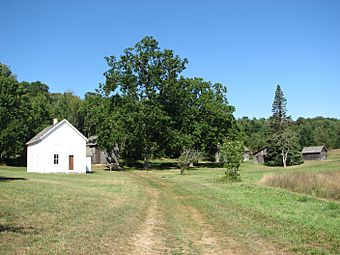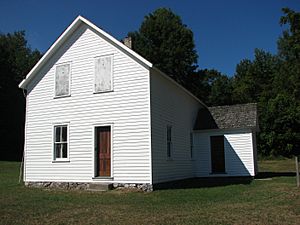George Conrad Hutzler Farm facts for kids
Quick facts for kids |
|
|
George Conrad Hutzler Farm
|
|
 |
|
| Location | South Manitou Island |
|---|---|
| Nearest city | Glen Haven, Michigan |
| Area | 160 acres (65 ha) |
| NRHP reference No. | 91000466 |
| Added to NRHP | May 3, 1991 |
The George Conrad Hutzler Farm is a special old farm located on South Manitou Island in Lake Michigan. It's also known as the Conrad Hutzler Farm.
One of the farm's owners, George Conrad Hutzler, Jr., was a pioneer. He was the first to try mixing different types of rye and pea beans to create new, better kinds. Because of his work, within 20 years, 80% of the pea bean crops in the United States came from Michelite seeds grown right here on South Manitou Island! This farm was added to the National Register of Historic Places in 1991.
Contents
The Farm's Story
Early Days of the Hutzler Family
George Conrad Hutzler was born around 1822 in a small village in Bavaria, Germany. In 1845, he moved to America with his wife Magdalena and their son. George Conrad Hutzler probably worked as a sailor on the Great Lakes.
His half-brother, George Johann Hutzler, also came from Germany in 1854. George Johann and his family moved to South Manitou Island around 1860. George Conrad Hutzler followed them about eight years later, in 1868. In 1870, he claimed the land for this farm, which was close to his half-brother's farm.
Growing New Crops
George Conrad Hutzler passed away in 1896 and was buried on the farm. His son, George Conrad Jr., who was born on the island in 1872, took over the farm. George Conrad Jr. and his own son, Lewis, managed the farm for many years.
In the 1920s, scientists from Michigan Agricultural College (now Michigan State University) chose South Manitou Island for important experiments. They wanted to create new types of rye plants. The island was perfect because it was far from other rye crops. This distance stopped different plants from accidentally mixing their pollen. The Hutzler family was a key partner in this work. They won many awards for the new kinds of Rosen Rye and Michelite pea beans they helped develop.
Changes Over Time
During the Great Depression, which was a very tough economic time, it became harder to transport crops across the Great Lakes. Farmers on South Manitou Island struggled to get their crops to market. Even the special experimental farming, like what the Hutzlers did, couldn't keep the farms going.
Because of these difficulties, families started leaving the island in the 1940s. Louis Hutzler eventually got married and moved to Hastings, Michigan. George Conrad Hutzler Jr. died on the farm in 1951 and is also buried there.
After George Conrad Hutzler Jr. passed away, a group led by William Boals bought the farm. They rented it to the Riker family. However, the plans for development never happened. In 1970, Boals sold the property to the National Park Service. The Rikers, who were the last active farming family on the island, were asked to move. The farm, along with other properties on South Manitou Island, then became part of the Sleeping Bear Dunes National Lakeshore.
What the Farm Looks Like
The George Conrad Hutzler Farm covers about 160 acres (65 ha) near the middle of South Manitou Island. The farm has a house, a barn, five sheds, a chicken coop, and a granary. These buildings are surrounded by old fields that were once used for farming.
The Main House
The George Conrad Hutzler house is a 1-1/2 story building made of wood. It has wooden boards overlapping each other on the outside and sits on a concrete base. The roof is V-shaped (called a gable roof) and covered with hexagonal slate tiles. The main part of the house is about 30 feet (9.1 m) by 30 feet (9.1 m). There's also a small addition on one side with a single-sloped roof.
The Big Barn
The barn also has a V-shaped roof and sits on a wooden base. Its sides are covered with vertical wooden boards, and the roof has wooden shingles. It measures about 58 feet (18 m) by 36 feet (11 m). On one side, there are two large double wooden doors.
Other Farm Buildings
The five sheds on the farm all have V-shaped roofs and are made of wood. They include:
- A two-story building, about 18 feet (5.5 m) by 20 feet (6.1 m), with wooden shingles and siding made of wide boards with narrow strips covering the gaps.
- A one-story building, about 18 feet (5.5 m) by 10 feet (3.0 m), with an asphalt roof and tarpaper siding.
- A one-story building, about 4 feet (1.2 m) by 16 feet (4.9 m), with wooden shingles and horizontal wooden board siding.
- A one-story building, about 39 feet (12 m) by 21 feet (6.4 m), with asphalt shingles and horizontal wooden board siding.
- A one-story building, about 10 feet (3.0 m) by 16 feet (4.9 m), with wooden shingles and horizontal wooden board siding.
The chicken coop is made of two connected parts. The larger part is about 10 feet (3.0 m) by 22 feet (6.7 m). It has a single-sloped roof covered in asphalt and vertical wooden board siding on a wood base. The smaller part is about 10 feet (3.0 m) by 13 feet (4.0 m). It has a V-shaped roof covered in asphalt and vertical wooden board siding on a wood base.
The granary is a 1-1/2 story wooden building, about 18 feet (5.5 m) by 20 feet (6.1 m). It has a small one-story shed attached to its back. It sits on a wood base and has a V-shaped roof with wood shingles. There's also a corn crib, a structure for storing corn, on one side.








